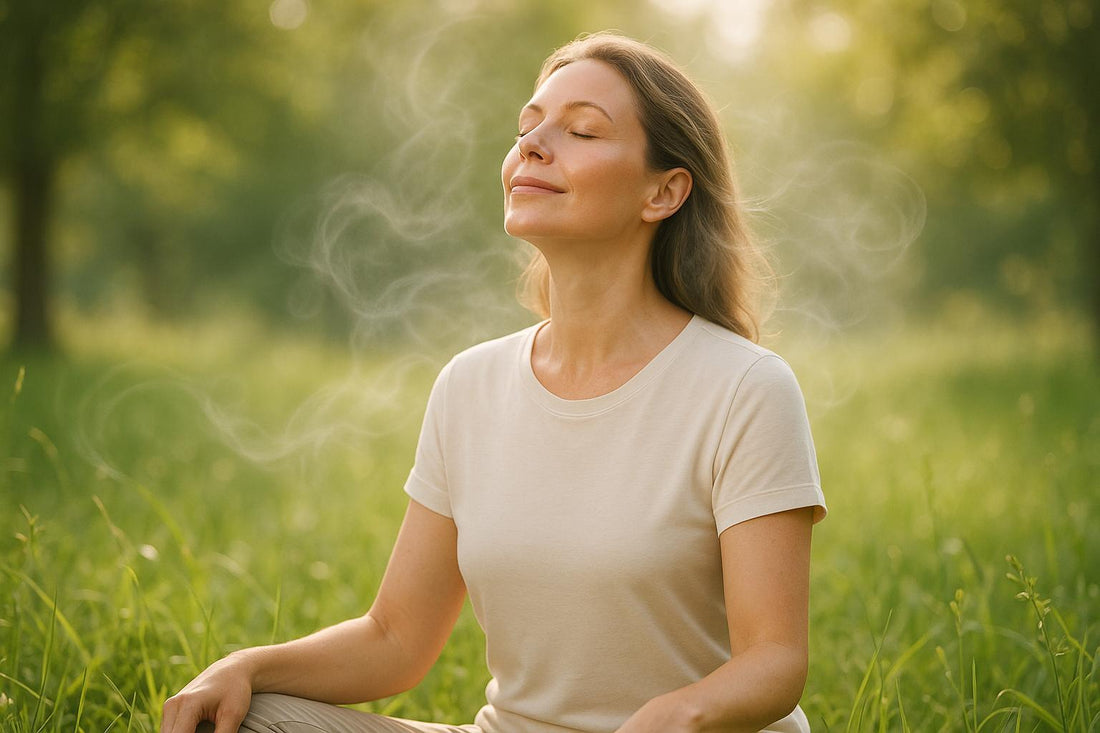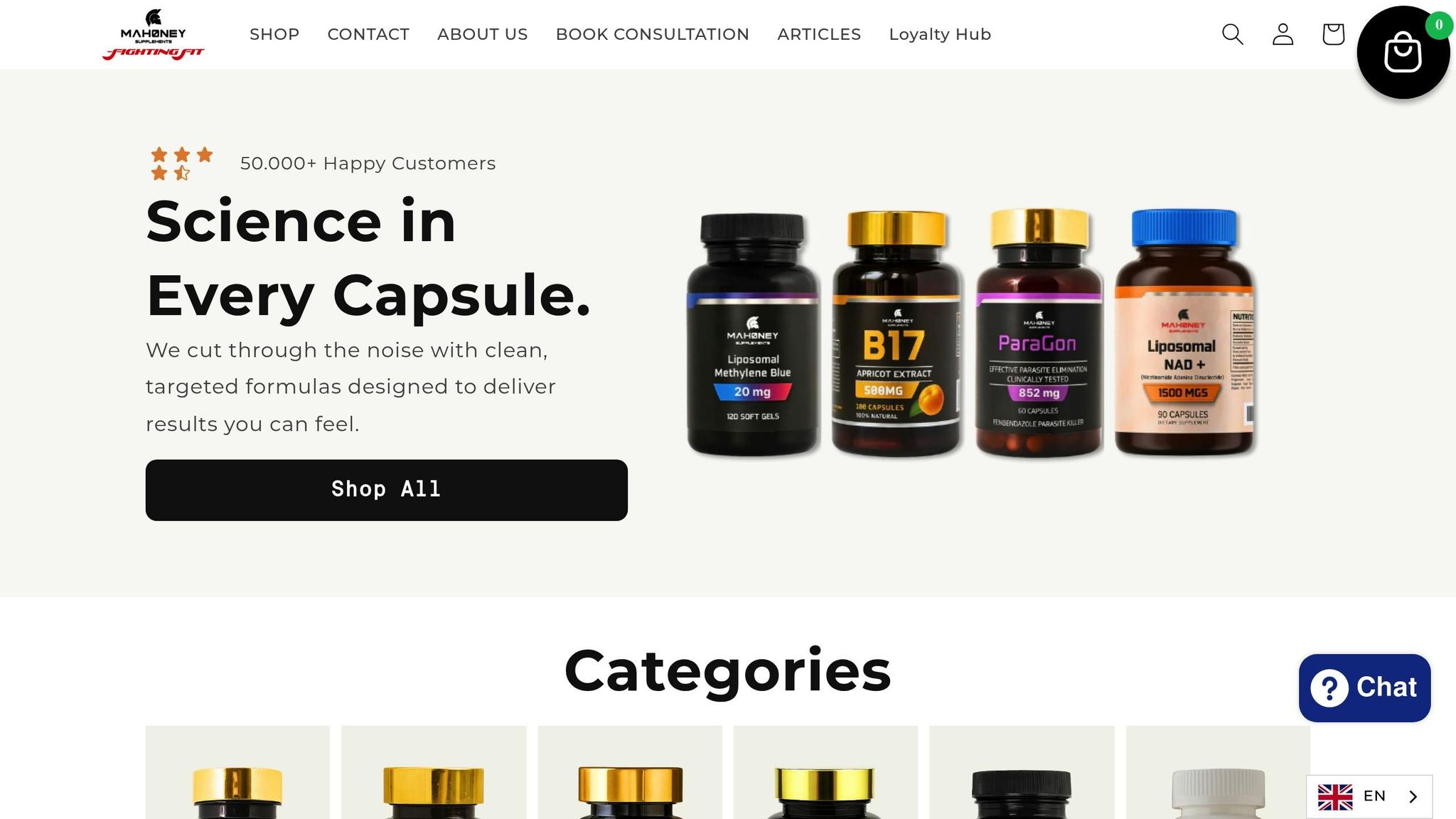
Oxygenation for Anti-Aging: What to Know
Share
Oxygenation therapy is gaining attention as a way to support healthy aging by improving how the body uses oxygen at the cellular level. It’s used to boost energy production, enhance skin health, and reduce inflammation. Popular methods include hyperbaric oxygen therapy (HBOT), oxygen facials, and lifestyle changes like breathing exercises.
Key Takeaways:
- What It Does: Increases oxygen supply to cells, aiding repair and reducing signs of aging like wrinkles and dull skin.
-
Popular Methods:
- HBOT: Breathing pure oxygen in a pressurized chamber to improve blood flow and tissue repair.
- Oxygen Facials: Concentrated oxygen applied to the skin for hydration and a temporary glow.
- Lifestyle Changes: Exercises like deep breathing and spending time outdoors to naturally increase oxygen levels.
- Benefits: Supports collagen production, reduces inflammation, and improves cellular detoxification.
- Risks: HBOT may cause ear pressure or oxygen toxicity; oxygen facials can irritate sensitive skin. Always consult professionals.
While promising, more research is needed to fully understand its long-term effects. For added support, natural supplements like TUDCA & NAC or ParaGon can improve detoxification and cellular health, complementing oxygen-based therapies.
How Oxygenation Slows the Aging Process
Delving into how oxygen functions at the cellular level helps explain why oxygenation therapies are gaining attention in the fight against aging. The aging process involves several biological changes, and oxygen plays a key role in supporting everything from maintaining youthful skin to helping cells handle the wear and tear that accumulates over time.
Oxygen's Role in Cellular Regeneration
Fibroblasts, the cells responsible for producing collagen, rely on oxygen to do their job. Collagen is what keeps skin firm and elastic, so oxygen is essential for maintaining that youthful appearance. Oxygen also plays a role in angiogenesis, which is the formation of new blood vessels. These vessels are crucial for delivering nutrients and removing waste from tissues. As we age, blood vessel formation naturally slows down, which can impact circulation and tissue health. Boosting oxygen levels may counteract this decline, improving overall tissue function. On top of that, oxygen helps regulate inflammation, which is another factor tied to aging.
Reducing Inflammation and Oxidative Stress
Chronic inflammation is a major contributor to cellular damage over time. Oxygen therapies may assist the body in managing inflammation more effectively, improving how cells function and heal. Well-oxygenated tissues tend to repair themselves more efficiently, which can help minimize long-term damage. While oxidative stress - caused by an imbalance between free radicals and antioxidants - can harm cells, proper oxygenation can improve cellular efficiency. This, in turn, may help reduce the production of harmful free radicals, mitigating some of the damage associated with aging.
Clinical Studies on Oxygenation and Aging
The potential benefits of oxygenation are backed by early clinical research. Studies on hyperbaric oxygen therapy (HBOT) have shown promise in addressing some age-related issues, both cognitive and physical. For instance, HBOT has been linked to improvements in memory, attention, and processing speed in older adults, likely due to enhanced blood flow and better cell function in critical areas of the brain. Oxygen-based treatments have also been associated with healthier skin, including increased collagen density, improved elasticity, and faster wound healing. Other studies have noted positive effects on cardiovascular health and other organ systems. However, individual results can vary, and more long-term studies are needed to fully understand the potential of these therapies.
Oxygenation Techniques for Anti-Aging
Boosting oxygen levels in the body can be achieved through various methods, each offering distinct benefits. Knowing how these techniques work can help you choose the best fit for your anti-aging goals and daily routine.
Hyperbaric Oxygen Therapy (HBOT)
HBOT is a fascinating method that not only aids cell rejuvenation but also supports collagen production, making it a popular choice for anti-aging.
What is HBOT? It’s a therapy where you breathe pure oxygen in a pressurized chamber, typically at 1.5–3 times normal atmospheric pressure. This setup allows your lungs to absorb much more oxygen than they would under regular conditions.
Here’s how it works: During a session, you lie inside a transparent chamber for 60 to 90 minutes while breathing 100% oxygen. The increased pressure helps dissolve oxygen into your blood plasma, cerebrospinal fluid, and other body fluids. This process delivers oxygen to tissues that might not be receiving enough blood flow.
The benefits of HBOT include stimulating new blood vessel growth, reducing swelling, and combating bacteria. For anti-aging, it’s particularly valued for promoting collagen formation, improving skin texture, and enhancing overall cellular repair.
Treatment Details: A typical course involves 20 to 40 sessions over several weeks, with each session lasting 60 to 120 minutes. Sessions are often scheduled daily or a few times per week, depending on individual needs.
Are there risks? While generally safe when administered by professionals, some potential side effects include ear pressure discomfort, temporary vision changes, and, in rare cases, oxygen toxicity. Claustrophobia can also be an issue for some people. It’s not suitable for everyone, especially those with certain lung conditions or untreated pneumothorax.
If clinical treatments aren’t your thing, there are non-invasive options for skin rejuvenation.
Oxygen Facials
Oxygen facials offer a gentler, skin-focused way to enhance oxygen levels. These treatments deliver concentrated oxygen directly to the skin, often paired with nourishing serums.
How does it work? A specialized machine converts regular air into oxygen, which is then applied to the face using a wand or mask. The process starts with cleansing and exfoliating the skin. Then, the oxygen is gently sprayed onto the face, often accompanied by serum infusion. The sensation is cool and soothing, like a light breeze.
What are the benefits? Oxygen facials can hydrate the skin, improve the absorption of skincare products, and temporarily smooth fine lines. They aim to boost oxygen levels in skin cells, supporting natural repair processes and leaving the skin looking more radiant.
The results are immediate but short-lived, lasting a few days to a week. For longer-lasting effects, regular sessions - monthly or bi-monthly - are recommended. The treatment is suitable for most skin types and involves no downtime. Side effects, such as mild redness or sensitivity, are rare, making it a great option for those with sensitive skin.
For a more natural approach, lifestyle changes can also help improve oxygenation.
Breathing Exercises and Lifestyle Changes
Simple adjustments to how you breathe and live can significantly improve your body’s oxygen levels - no fancy equipment or appointments required.
Breathing Techniques:
- Deep diaphragmatic breathing is a great starting point. Place one hand on your belly and the other on your chest. Inhale slowly through your nose, letting your belly rise while keeping your chest still. Exhale through pursed lips. Practicing this for 5 to 10 minutes daily can make your breathing more efficient.
- Box breathing is another effective method. Inhale for four counts, hold your breath for four counts, exhale for four counts, and hold again for four counts. This technique helps regulate your breathing and can gradually increase oxygen saturation.
Exercise and Posture:
Regular cardiovascular exercise - like brisk walking, swimming, or cycling - improves how your body uses oxygen. Just 30 minutes of moderate activity most days can enhance oxygen delivery to your tissues. Posture matters too. Slouching compresses your lungs, limiting their capacity. Standing or sitting with a straight spine allows for better lung expansion and oxygen flow.
Environment Matters:
Spending time outdoors, especially in green spaces, exposes you to higher oxygen levels. Indoor plants can also improve air quality, making your home or workspace more oxygen-rich.
These lifestyle changes are simple, accessible, and affordable. Though the effects may take longer to notice compared to clinical treatments, they offer long-term benefits for your overall health. Better oxygen delivery supports skin health, cellular repair, and the natural anti-aging processes of your body.
Safety and Limitations of Oxygenation for Anti-Aging
Oxygenation techniques may hold potential in the realm of anti-aging, but they aren't without risks and limitations. Being aware of these concerns is key to making informed choices about incorporating these methods into your wellness routine.
Potential Side Effects and Risks
Hyperbaric Oxygen Therapy (HBOT) comes with its own set of risks. Oxygen toxicity, for instance, can lead to seizures, lung irritation, or vision problems. The pressurized environment of HBOT may also cause barotrauma, which can affect the ears, sinuses, or lungs. Common issues include middle ear discomfort or changes in hearing. Certain conditions, such as untreated pneumothorax, specific heart problems, claustrophobia, or active respiratory infections, make HBOT unsuitable for some individuals.
Another concern is the heightened fire risk due to the high oxygen levels involved in HBOT sessions, which is why strict safety measures are essential.
Oxygen facials can trigger redness, irritation, or even allergic reactions, particularly for those with sensitive skin.
Breathing exercises, while generally safe, can cause dizziness, tingling, or fainting if done incorrectly. Individuals with chronic respiratory issues, such as COPD, should always consult a healthcare provider before engaging in intensive breathing practices.
To minimize risks, it's important to work with experienced professionals and use modern, well-maintained equipment. Keep in mind that safety and outcomes can vary significantly from person to person.
Individual Differences in Results
The effectiveness of oxygenation therapies isn't one-size-fits-all. Genetics, overall health, and lifestyle choices - like smoking habits and diet - play a big role in how someone responds to these treatments.
For younger individuals, who typically have more robust cellular repair mechanisms, results may appear more quickly. Older individuals, however, might need longer treatment periods to see benefits. Conditions like poor circulation can also limit how well oxygen reaches tissues, potentially reducing the visible effects of therapy. Additionally, factors like stress and physical activity levels can influence outcomes.
Medications can further complicate matters, as certain drugs may alter how the body reacts to increased oxygen levels.
Research Gaps and Uncertainties
The science behind oxygenation for anti-aging is still in its early stages. Most studies have focused on medical uses rather than cosmetic or anti-aging applications, leaving many questions unanswered about long-term effects and best practices.
HBOT protocols, for example, vary widely in terms of pressure, session length, and frequency, making it difficult to establish standardized guidelines. While short-term use of HBOT appears relatively safe for healthy individuals, the effects of extended treatments over years remain unclear. Some evidence suggests that prolonged exposure to high oxygen levels could increase oxidative stress, but this remains inconclusive.
Other challenges include potential placebo effects, a lack of studies examining cost-effectiveness, and limited understanding of how oxygenation therapies interact with other anti-aging methods. These gaps highlight the importance of cautious integration, especially when combining oxygenation with supplements or other treatments.
sbb-itb-9616115
Supporting Oxygenation with Natural Supplements
Boosting oxygen levels in the body can play a key role in slowing down the aging process, aiding cellular repair, and promoting detoxification. By incorporating natural supplements into the mix, you can further amplify these benefits, creating an environment that supports optimal cellular health.
Supplements That Aid Cellular Regeneration
A healthy liver is crucial for detoxifying the body and maintaining the metabolic processes that drive cellular repair. When the liver efficiently eliminates toxins, your cells are better equipped to regenerate and function effectively.
Mahoney Supplements' TUDCA & NAC is a powerful combination designed to support liver health. TUDCA helps protect liver cells and improves bile flow, while NAC boosts glutathione levels, which strengthens your body's antioxidant defenses. Together, these compounds enhance the body's ability to process toxins, making oxygenation therapies even more effective by optimizing cellular metabolism.
Another supplement, B17, provides additional support by promoting immune function and aiding detoxification. This creates a favorable internal environment for cells to respond more effectively to oxygen-based treatments.
Detoxification and Cellular Regeneration: A Crucial Link
To maximize the benefits of oxygenation, it’s essential to focus on detoxification. When cells are overloaded with toxins, their ability to repair and regenerate is compromised, which can diminish the effectiveness of oxygen therapies.
ParaGon, a supplement designed to cleanse the body of parasites, helps remove toxins that interfere with cellular repair. By creating a toxin-free environment, it allows oxygenation treatments to deliver better results.
For a more comprehensive approach, the Super Charged Anti-Aging Kit offers a synergistic blend of supplements aimed at enhancing cellular repair and overall wellness. Priced at $112.95, this kit supports the body's natural healing processes and complements anti-aging strategies.
Why Mahoney Supplements Stands Out

Combining natural supplements with oxygenation therapies can create a powerful anti-aging regimen. Mahoney Supplements focuses on using natural, high-quality ingredients that work in harmony with the body’s systems. This approach ensures that the supplements not only support cellular health but also avoid synthetic additives that could disrupt delicate biological processes.
The company, founded by David G. Mahoney, is committed to delivering products that emphasize purity and efficacy. This dedication makes their supplements an excellent choice for those looking to enhance the benefits of oxygen-based treatments while supporting natural cellular regeneration.
Key Takeaways on Oxygenation for Anti-Aging
Let’s break down how oxygenation and supportive supplements can play a role in slowing the aging process:
The Benefits of Oxygenation
Oxygenation techniques can help slow down aging by improving how cells repair themselves, reducing inflammation, and keeping cells functioning efficiently. These benefits often show up in noticeable ways, like smoother skin texture, fewer fine lines, and improved elasticity.
When your cells are working at their best, your body becomes more equipped to handle oxidative stress, maintaining healthier tissues across your skin and other organs.
Therapies like hyperbaric oxygen treatments, oxygen facials, and even specific breathing exercises offer different methods to boost cellular oxygenation. Whether you’re looking for targeted treatments or everyday strategies, these options can deliver meaningful results.
Combining Supplements and Lifestyle Changes
For the best results, oxygenation techniques should go hand-in-hand with proper nutrition and detoxification. Healthy, toxin-free cells are essential for effective oxygenation.
Products like TUDCA & NAC, ParaGon, and the Super Charged Anti-Aging Kit from Mahoney Supplements are designed to support liver health, improve detoxification, and encourage cellular regeneration. These supplements can amplify the benefits of oxygen therapy by creating an ideal environment for your cells to thrive.
Pair these supplements with consistent breathing exercises, staying well-hydrated, and professional oxygen treatments to promote deeper cellular repair. By focusing on both oxygenation and detoxification, you’re giving your body the tools it needs to repair and regenerate from the inside out.
FAQs
What are the long-term benefits and risks of oxygenation therapies for anti-aging?
Oxygenation therapies, like hyperbaric oxygen therapy (HBOT), are gaining attention for their potential in slowing the aging process. Studies indicate they might help extend telomere length, support cellular repair, and decrease markers associated with biological aging. When applied properly, these treatments are generally considered safe.
That said, overexposure to oxygen (a condition known as hyperoxia) can result in oxygen toxicity. The long-term safety of these therapies remains under investigation. While early results are encouraging, more in-depth research is necessary to fully evaluate their long-term risks and rewards.
How do breathing exercises compare to hyperbaric oxygen therapy for anti-aging benefits?
Hyperbaric oxygen therapy (HBOT) is often viewed as a more targeted approach to anti-aging compared to breathing exercises. HBOT operates at the cellular level, promoting longer telomeres, reducing the presence of aging cells, and enhancing mitochondrial function - all crucial elements in slowing down the aging process.
Breathing exercises, while valuable for promoting relaxation, reducing stress, and supporting lung health, don’t directly address cellular aging in the same way HBOT does. For individuals looking for noticeable anti-aging benefits, HBOT provides a more focused and impactful option.
Can oxygenation therapies be used alongside other anti-aging treatments, and what precautions should be taken?
Yes, oxygenation therapies like hyperbaric oxygen therapy (HBOT) can often be paired with other anti-aging treatments to boost their effectiveness. These therapies are known to promote collagen production, combat oxidative stress, and aid in cellular repair, making them a strong complement to anti-aging routines. That said, combining treatments requires careful consideration.
It’s crucial to consult a healthcare professional before starting, especially if you have conditions like lung issues, recent surgeries, or active infections that could pose risks. A tailored plan ensures you can enjoy the benefits of oxygenation therapy while keeping safety a top priority. Always rely on expert guidance when blending treatments for the best results.
